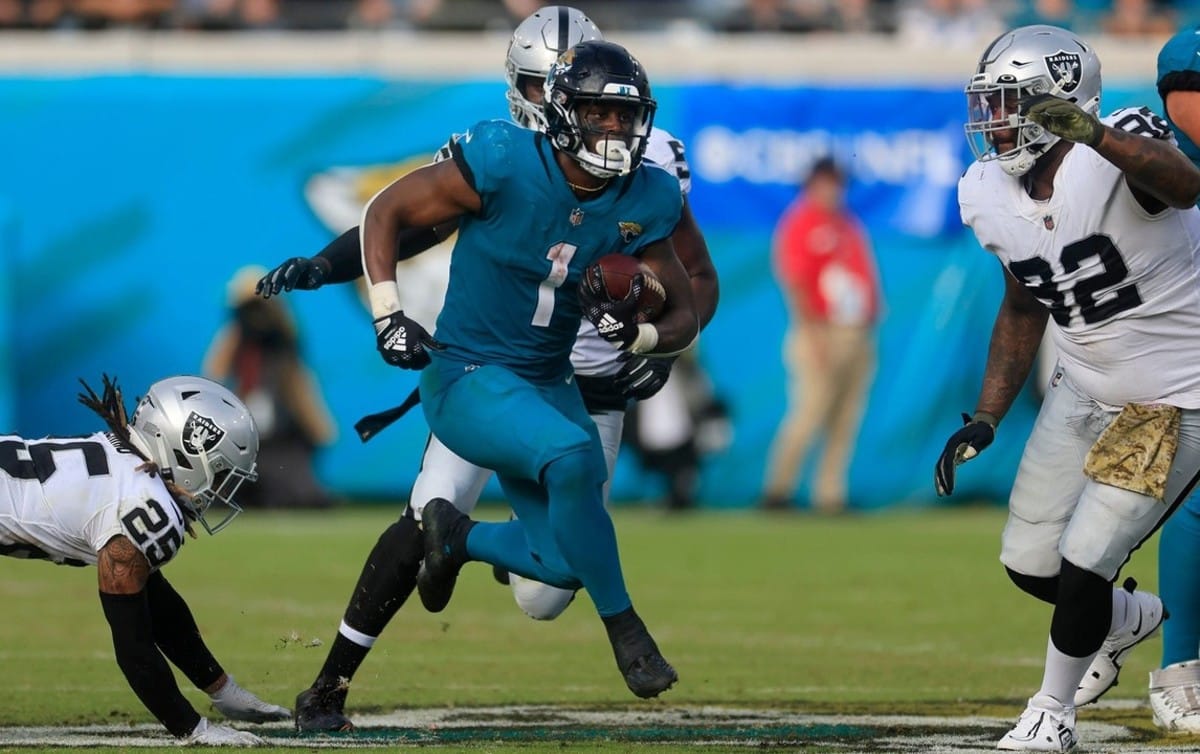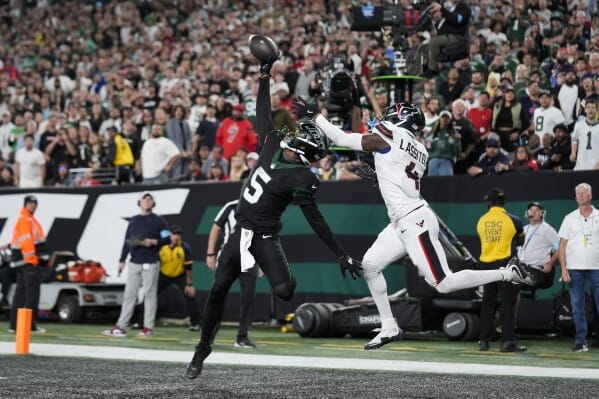
RB Success Rate Stars
No matter which form of fantasy football we're talking about, touchdowns are massively important.
This is especially true for running backs, whose ability to consolidate goal-line touches creates upside for huge TD totals. Those high-end TD outcomes can alter the fantasy landscape.
In 2021, I looked at the 36 RB seasons since 2000 where an RB scored 23+ PPR points per game. Unsurprisingly, TDs were a huge part of the target profile that emerged.
Given that a half-PPR tournament currently offers best ball's biggest prize, hitting on elite TD totals is as important as ever.
Opportunity is King
To score TDs at a high rate, RBs need to be set up for success. In other words... they need to see touches near the goal line. This can be measured by looking at green-zone opportunities, i.e., carries and targets inside the 10-yard line.
"Every single legendary season has come from a running back with at least 1.5 green-zone opportunities (carries + targets) per game. And 78% of legendary seasons were accompanied by 2+ green-zone opportunities per game."
As we know, opportunity is king at the running back position. A player can have all the talent in the world, but if his team consistently pulls him at the goal line, he's unlikely to deliver a league-winning fantasy season.
But touchdowns are not a niche stat that fantasy players alone care about. Scoring TDs is the literal point of real-life NFL offenses.
And while NFL coaches have their biases and personal preferences on goal-line usage, opportunity doesn't occur randomly. Coaches will generally favor RBs who are consistently delivering for the offense.
With that in mind, we might better predict future goal-line workloads by examining NFL Next Gen's success rate metric.
NFL Next Gen's Rushing Metrics
NFL Next Gen uses player tracking data to calculate the expected rush yards on a given play.
RBs can then be measured against that baseline to determine how many yards they are adding above expected. But this model can also measure how consistently an RB is hitting expectations. This is measured with NFL Next Gen's ROE% metric—which I will refer to as success rate.
This metric measures how often an RB ran for more yards than expected. A run of 99 yards over expected and a run for one yard over expected are treated the same by this measure; they are both counted as a positive play. This downplays highlight-reel runs and, instead, rewards backs for consistently churning out positive gains.
NFL coaches generally seem to favor consistent RBs rather than backs who are always looking to hit a home run. And if there's one area of the game where it would make sense to lean on your most consistent runner... it's at the goal line.
To get a sense of whether this is actually happening, I looked at RBs with 200+ carries who logged 150+ carries the following season. Their success rate was somewhat correlated with their goal-line opportunities the following year.

The correlation strengthens when looking at RBs with 200+ carries in both seasons.

To some extent, this isn't that helpful.
If I could predict which RBs would log 200+ carries with perfect accuracy, I would draft those backs and let the goal-line work sort itself out.
But although this isn't a particularly strong correlation, there appears to be at least something to the idea that consistent runners are better positioned for big-time goal-line workloads. And correctly identifying these high-end goal-line workload backs has been massively beneficial.
Simply finding a running back with a major goal-line role has been a good way to land on legends. Since 2000, 132 running backs have received 2+ green-zone opportunities per game. 21% of them have averaged 23+ points per game.
Since 2018, 12 RBs have logged 200+ carries and then averaged 1.9+ green-zone carries in the following season. In 10-of-12 cases, that RB had at least a 40% success rate in the previous season.

Clearly, green-zone carries aren't everything.
In 2018, Christian McCaffrey struggled with rushing consistency, with just a 36% success rate. But he was a highly efficient receiver, posting 1.77 YPRR and ranking RB1 in ESPN's receiver ratings. And he never left the field, leading all RBs in 2018 with a 91% snap share. If we see a profile like McCaffrey's again, we can overlook some rushing inconsistency.
Joe Mixon is the other outlier on the list. But even though he managed 2.0 green-zone carries per game last season, he ceded significant snaps to Samaje Perine down the stretch.
2022 Success Rate Stars

In 2022, 15 RBs handled 200+ attempts while achieving a 40%+ success rate. Drafters are generally on board with the idea that this list contains many of the NFL's best runners. 8-of-12 have ADPs within the top 40 picks.
D'Onta Foreman
D'Onta Foreman was very impressive last season, racking up 164 rush yards over expected, the eighth most in the NFL. But the consistency with which he achieved a positive run – as measured by his elite 49% success rate – was just as impressive.
Foreman is now competing with Khalil Herbert, who finished fifth in RYOE and also had a very impressive 47% success rate. However, Herbert only had 129 attempts last season, so his rushing ability is a little more uncertain.
Then again, Herbert was efficient behind a weaker offensive line and should have the upper hand with the Bears' coaching staff.
I've been targeting both RBs, given that there should be no shortage of rushing attempts in Chicago.
Aaron Jones
Aaron Jones turns 29 in December, so we should be on the lookout for any indications that he's falling off. But Jones continued to look strong last season, with an elite 49% success rate.
Jones' consistency helps explain why A.J. Dillon hasn't emerged as a big-time TD producer. Dillon rushed for seven TDs to Jones' two. But Jones caught five TDs to Dillon's zero. Dillon had a very strong 46% success rate last season and will likely operate as the primary goal-line back. But there's no need for the Packers to pull Jones when in close.
Jones has been a challenging selection for me in a part of the draft where I'm usually hellbent on drafting a receiver. But he does not appear to be in serious decline and is someone I'll be targeting a bit more in the future.
Nick Chubb
Nick Chubb led the NFL with 389 RYOE in 2022. Stunningly, he's never finished lower than third in the metric. Chubb is often called the NFL's best pure rusher... there's a reason for that.
Chubb's ability to pair explosion with consistency makes him an appealing pick on an offense that should take a step forward this season. Unfortunately, drafters aren't sleeping on Chubb. After being very affordable before the NFL Draft, Chubb is back in the mid-2nd round. As a result, I'm currently underweight.
But the sheer majesty of Chubb's rushing efficiency has me reconsidering whether his receiving red flags and age (he turns 28 in December) are enough to warrant fading the rushing superstar in half-PPR.
It's also possible that he could see more receiving game work with Kareem Hunt no longer on the team. Since entering the league in 2018, Chubb ranks RB21 in ESPN's receiver ratings. That's higher than receiving superstar Alvin Kamara (RB24). Chubb's rating in this metric would likely fall with more opportunities. But it still indicates that the Browns have been underutilizing him in space.
I plan to get more exposure to Chubb in future drafts. I'd like to be at least even with the field by the end of draft season, as long as I can do it without chasing him into the early 2nd round.
Tyler Allgeier
Tyler Allgeier took a while to get going last year but ultimately put together a very impressive rookie season. Unfortunately, he now backs up the No. 8 overall pick.
And it's hard to know how much work Allgeier will even get behind Bijan Robinson. Cordarrelle Patterson only had 144 attempts last season, but he posted an elite 50% success rate, with 78 rushing yards over expected. Patterson will operate in a specialty role but could still limit Allgeier's impact.
Patterson's success could also indicate that Allgeier benefited from an efficient rushing scheme. Caleb Huntley only logged 76 attempts in 2022, but he delivered 80 yards over expected with a ridiculous 55% success rate. So, relative to his teammates, Allgeier wasn't all that impressive. That makes the Falcons' selection of Robinson a little more understandable.
But it's still encouraging that Allgeier was highly efficient on a meaningful rookie sample size. Behind Robinson, he's a pure contingent play. But Allgeier looks plenty capable of taking over the bulk of the workload for any games Robinson misses. And he should be a trusted runner when the Falcons are in close... if Robinson isn't available.
Travis Etienne
Travis Etienne is one of the more misunderstood RBs in the NFL. This partially stems from the fact that Urban Meyer drafted him to help soothe the pain of being sniped on Kadarius Toney.


